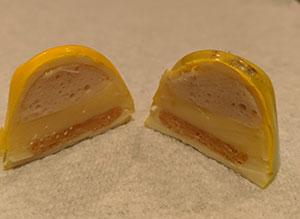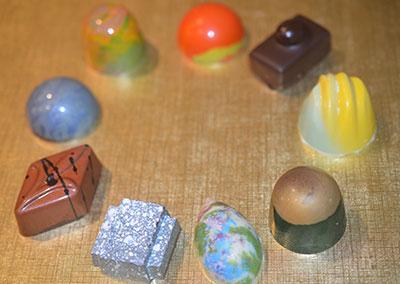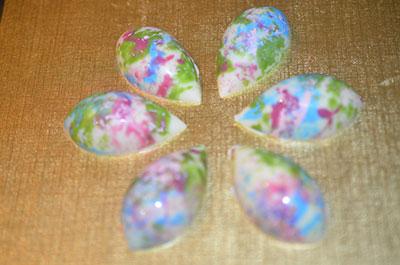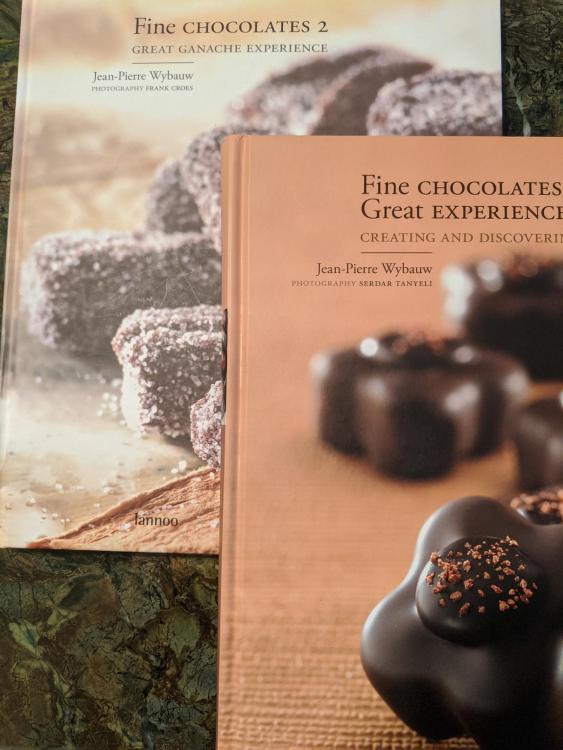-
Posts
2,411 -
Joined
-
Last visited
Content Type
Profiles
Forums
Store
Help Articles
Everything posted by Jim D.
-
@pastrygirl, beautiful, and a great shine, especially for 80F. I did not fare so well at 70F. The dark items came out beautifully, but the milk ones stuck horribly. It's a first time for 4 molds turned upside down, tapped, and.... nothing came out. With some perseverance (and time in the freezer), I eventually got almost all of them out. But back to your hearts. I love the decoration on the honey caramel, a sly hint of what's inside. Did you paint on the stripes? I did that once and thought I would cut my wrists before I finished. And I like the concept of cinnamon mocha. Is that one a caramel or ganache? Having tasted your caramels, I can attest to their excellence. Are you sure you don't need some more Aw readings done in exchange for aforementioned caramels?
-
Regarding the Chef Rubber "natural" colors: There was a discussion on this forum about the new Chef Rubber Zen colorant line. Previous CR lines have listed ingredients in detail, but the Zen color list is very vague (doesn't even say whether there is titanium dioxide). In that thread you can see that one participant contacted CR and spoke to someone who was helpful about the actual ingredients. It's a bit frustrating in that I can recall ingredient lists for other food products in the past mentioning something like beets when that was what produced the red color of the product in question. To be clear, I have never used or even seen the "Natural" line of colors from CR, but the consensus on eG seemed to be that the colors were subdued. The Zen colors I have tried were very bright. They do, not unexpectedly, include titanium.
-
The recipe seems to foresee what you had happen: And the author states at the beginning: You are dealing with adding eggs to a warm caramel, so I don't think you can expect it to behave as a plain caramel would, and I would anticipate all sorts of ugliness occurring. But how did your pie turn out?
-
Since my pineapple experiments posted earlier (the ones you found), I have continued to work on my fruit caramel recipes. The white chocolate approach does work, but if someone wants to get the "pure" caramel-plus-fruit taste (no chocolate), there is no way I have found to avoid the strong possibility of scorching when using the normal method. I now add flavoring after the caramel has been completely cooked. You may not like or even approve of this approach, but at times I can be practical, and it's the flavor I care about (plus not having the ugly separation issue, even sometimes when using an immersion blender). I was present a few days ago when one of my customers ate a mango and passion fruit caramel, and her comments on the taste cemented my decision to use this method. So I cook the caramel (to be piped) to the hardball stage, where you would normally cook a caramel to be cut, then remove from the heat and add the butter with a blender. If there is a bit of separation, I don't panic because I know it will be fixed later (see below). Then I add flavoring, and for this I use Amoretti's "natural artisan" flavorings. According to the labels, these are mostly fruit with various types of sugars added, but the key is that the fruit purée has already been reduced--so no scorching. In addition to the two I mentioned, I have used apricot, cherry, raspberry, and pineapple. I find the flavors of these ingredients strong and authentic; the downside is that they are expensive. Using them has the additional advantage that it adds to the water content of the caramel, thus making the emulsification of the butter easier--I have not had a single case of separation since I began using them. One other hint I learned from Kerry Beal (who else?) is to add a pinch of citric acid; this cuts the sweetness substantially. With your pineapple and coconut experiment (which sounds very promising), I think citric acid would be a must for the caramel. On caramel emulsification in general: @teonzo posted a comment explaining the science that helped me. So when caramel separates, I now realize that it is just like a ganache in that more liquid is needed. Therefore I cook caramel beyond the soft ball stage so that it can be thinned out if necessary; I have also reduced the quantity of butter I add (and detect no taste difference).
-
Good ideas. There is also the possibility of using a graham cracker.
-
If you do a search for low-sugar cookies, you will find some ideas. Substituting an artificial sweetener (such as Splenda) will not decrease the sweet taste, maybe even increase it, but some people say it is fine to reduce sugar in a recipe by 25%, though that will affect browning. In searching, I found one cookie recipe (intended for children) that had practically no sugar, but I would not expect great taste. Maybe adding other flavors to the cookie (lemon zest, cinnamon) would help. You could also look into recipes for shortbread (which is what I often use), which tends to be less sweet.
-
I would say the reflection is easy to accomplish with the appropriate software. I fact, I think (but don't have all the time it would take to search) that this sort of reflection has been discussed on eG. I don't believe that in real life it would ever be so perfect. In theory the gradients are possible, but I've never heard of anyone who has the ability to control airbrush spray to that degree. And one would have to be a bit crazy to use tape. You didn't provide the source of the image.
-
I would add up to 10% of colorant to cocoa butter and make sure it is in temper. Mixtures of some colors (the metallic ones especially) tend to be more viscous than others, but none should behave as yours are.
-

Your Daily Sweets: What Are You Making and Baking? (2017 – )
Jim D. replied to a topic in Pastry & Baking
That one looks especially delicious. Are you willing to share the recipe for the topping, or at least the ingredients? -
I checked the Aw of the fillings I made: one with crushed ladyfingers mixed in, the other with the separate cookie. Both were remarkably low: 0.66 and 0.69. I too had qualms about adding cheese to ganache, but everyone seemed to think that if the water activity level is low enough, there is no issue. The tipping point for me was to find Peter Greweling's crème fraîche ganache. If he does not find a problem with that, then mascarpone is not that different.
-
I have completed my experiment with creating a tiramisu bonbon. First I baked eggless "ladyfingers." I use quotes because although these looked similar to ladyfingers, they certainly did not have the light, airy texture or the taste. When baked for the time specified by the recipe, they tasted mostly of raw flour. Only after being baked for a half-hour or more until they browned a bit did they have any taste at all. I ended up throwing the leftover ones in the trash. The mascarpone coffee ganache went well. I used instant espresso powder to obtain the coffee flavor, and it was successful. When the ganache was complete, I divided it into halves. Into one half I added pulverized ladyfingers, and with the other, topped the ganache with little cookies I had baked from the same batter. The result: In the first batch, the crushed ladyfingers basically dissolved into the ganache with no discernible taste and not much texture. The second was more successful: after one day, the ladyfinger cookies maintained their texture; by the second day, they had some crispness but were noticeably softer. I feel sure the softening will continue (inevitable movement of moisture from wet item to dry). At least there was some pleasing contrast between the coffee ganache and the cookie (see below for alternative bonbon idea). The mascarpone was, however, the biggest disappointment. I think any taste it contributed was in my imagination. It is simply too mild a cheese to be tasted in proximity to the dark chocolate shell. In my version of Susanna Yoon's cheesecake ganache, I use cream cheese and sour cream, and although they also are mild, still they have some tang contrasted with mascarpone. My conclusion is that I will probably not be adding tiramisu bonbons to my repertory of chocolates. If I made actual ladyfingers, they would dissolve in mush if added in pulverized form and probably do the same if added in cookie form because they are so porous (which is why they soak up the coffee in an actual tiramisu). As I ate this filling, I kept thinking that I would rather have had a bonbon with a layer of coffee ganache, topped with a small layer of hazelnut praline gianduja enclosing a shortbread cookie.
-

Spraying Chocolate: Equipment, Materials, and Techniques
Jim D. replied to a topic in Pastry & Baking
I agree about the overspray from white. I'm not sure why it happens, but it is bad. It also happens with metallic colors. I just purchased a spray booth that does a reasonably good job of removing the backspray (I call it that because the spray bounces off the booth and back at me). I also got a small electric fan which I place behind me, aimed at the spray booth, and that seems to help drive the spray back toward the fan that sucks it from the booth. If you like the trigger-style airbrush and are able to spend more money, I recommend the Grex Tritium airbrush (there is a review of this on eGullet). Grex tech support recommended 30psi, and that is about where I keep it. Grex also has a fairly large metal cup that holds enough cocoa butter for several molds (depending on their size, of course). The small cups on other airbrushes nearly drove me crazy. -
Upon further reading about tiramisu truffles, I think you are onto something--and I was overthinking the whole concept. Given that most people eat a bonbon in a single bite (maybe two), keeping the flavors distinct may not matter, so I could add (liquid) coffee (plus perhaps some Kahlua) to the cheese ganache. Since my adaptation of Susanna Yoon's recipe already includes 50g of lemon juice, I could simply substitute coffee for the lemon, and the proportion of liquefier to chocolate would be unchanged (always need to keep the water activity in mind). Once I see if that works tastewise, I can try (1) adding the ladyfingers as crumbs or (2) adding them as cookies, perhaps surrounded by white or dark chocolate to preserve their texture. I will report back. We all know there are many unforeseen twists between developing a new recipe and executing it.
-
Excellent idea. I make a crème brûlée bonbon, and to get the crunch, I make a hard-crack caramel and grind it in a food processor. If ground enough (but not too much), it will have crunch but will not be difficult to eat. But again, it won't last in humidity (I have the advantage of being able to encase the caramel bits in a little chocolate, protecting them from the elements).
-
Getting the right thickness of caramel for your purposes is not going to be easy. I don't know if you have ever eaten a candy apple, but it is a dentist's dream come true. Requires very, very careful eating. And, of course, you shouldn't try to make the caramel on a humid day. Your eaters' teeth may be stuck together permanently.
-
Not sure what the gianduja would be made of. Chocolate plus ... ? I think any kind of nut paste is going to add its own flavor.
-
Good idea. I've seen a recipe for chocolate ladyfingers, so coffee should be easy to do.
-
An interesting idea. Alas, I don't have a sous vide setup. I don't know what difference SV would make, but I could probably melt some chocolate (in a "normal" way) with coffee beans, strain out the beans, mix in some ground ladyfingers. This is akin to making a cookie butter "gianduja." Not sure what would happen to the ladyfinger taste. If I left the ladyfinger cookies whole, I could surround them with the coffee-infused chocolate, but would have to add something (e.g., coconut oil) to soften the chocolate somewhat.
-
I would like to have a discernible cakey texture (perhaps like a somewhat overbaked ladyfinger, or a soft cookie), but not a crunch. I agree about the cocoa powder; it probably would be lost in all the other ingredients.
-
My latest project is to make a "tiramisu" bonbon, and I am seeking help with the inclusion part. For the whipped cream and mascarpone layer in a traditional tiramisu, I will probably use Susanna Yoon's cheesecake ganache, substituting all mascarpone for the various cheeses she uses (it has white chocolate to firm it up a bit). It is the ladyfinger (savoiardi) and coffee part that concerns me. Most recipes call for the firmer savoiardi (rather than just-baked soft ladyfingers), which are then dipped in coffee (sometimes Kahlúa). I know that it is undoubtedly safe to use cooked eggs in bonbons, but I prefer not to do so and have located several recipes for eggless ladyfingers. The rise comes from baking powder and whipping the butter and sugar. So one question (not my main one): The best-looking recipe calls for a tablespoon of vinegar, and it's the only recipe I found that has this ingredient. I assume it has something to do with activating the baking powder. Can anyone explain this? The main issue is how to get the ladyfinger-dipped-in-coffee taste, maybe texture. One option is to grind up the ladyfingers (which I think would need to be baked a bit longer than traditional ladyfingers), then mix them with a coffee ganache (this is done in several tiramisu truffle recipes I found). Another method would be to cut the ladyfingers into rounds, then add them to the cavities after a thin layer of coffee ganache. In both cases the ladyfingers would soften, but of course that is what happens when you dip them in coffee in a traditional tiramisu. So the question is whether this would become a disgusting mush over time. Encasing the ladyfingers (ground up or left whole) in a gianduja would be an ideal solution, but I can't think of any way to get coffee flavor into a gianduja. I did see one suggestion for mixing powdered instant coffee into chocolate, but avoiding grittiness would be tricky. Yet another idea is spraying the "ladyfinger cookies" with cocoa butter to protect them from moisture, and if this technique didn't keep them firm forever, it would probably slow down the softening. Finished tiramisu is usually sprinkled with cocoa power, and I have some delicious Valrhona cocoa powder, but I can't think of any way to incorporate that without grittiness. So I'm planning to use dark chocolate for the shell to add the chocolate flavor. Any suggestions would be welcome.
-
You are really heading into uncharted territory now. Sounds delicious, though certainly too far out there for my customers, but still interesting. Can you say more about the three flavors and how they were made? Bacon has been discussed a lot on eGullet, and, if I recall correctly, the consensus was that bacon fat gave better flavor than bacon itself.
-
You might find some interesting combinations in this thread on flavor combinations. It covers both savory and sweet ideas, but there are lots of suggestions, some of which I have adopted.
-
As requested: (with thanks to pastrypastmidnight for her tips on doing "the cut," at which she is a recognized master) Tasting a new bonbon all assembled and ready to go is always different (to me) from tasting the components during production. This tasting told me the Notter lemon ganache recipe is great, but, when paired with marshmallow, it could use more zest. It's not clearly visible, but below the lemon there is a thin "moisture barrier" of white chocolate flavored with the wonderful Boyajian lemon oil, keeping the cookie crisp. I made some new discoveries about making pipeable marshmallow (this was the best it has ever turned out--it even self-leveled as I piped it into the molds), and I have incorporated those into the recipe I posted on using marshmallow in bonbons.
-
Chocolate assortment for May 2020, clockwise starting with orange sphere at top: dark chocolate ganache with orange & spiced honey, Irish coffee ganache topped with a coffee bean, "lemon meringue pie" (marshmallow meringue, lemon ganache, shortbread crust), "pecan pie" (dark caramel, pecan praline gianduja, pecan shortbread), strawberry ganache with St-Germain elderflower liqueur, caramel flavored with mango & passion fruit, hazelnut caramel, Speculoos cookie butter, apricot pâte de fruit & pistachio gianduja: Flowers on the outside, strawberry and elderflower on the inside:
-
Now that I have purchased the Wybauw all-inclusive "Gold" volume, I am offering for sale the two individual books I already have: Volumes 2 and 4. They have a great deal of information on shelf life and contain many recipes. In excellent condition. $50 + shipping charges for both of them (for sale together, not individually), payment via Paypal, shipment by USPS.






